Football Dosage and Approach ⇒ FAQ

My last article, New Ideas for Old School Football Coaches, was read by high school coaches all over the country. I’ve received dozens of emails from coaches who bought into the common sense of making speed the priority of high school football. Many football coaches consider my low-dosage outcome-based approach as revolutionary, if not sacrilegious.
“The reality of coaching is that outcome matters. Try making a living based on just your process, philosophy, or methodology.” – Jorge Carvajal.
What is the outcome that matters? Speed.
Long, hard practices kill speed. Quantity is a dumb idea. Everyone wants a QUALITY football team!
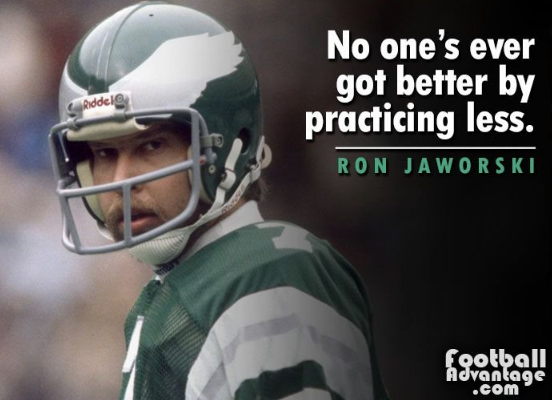
Sorry Jaws, maybe no one improved without practice but millions of athletes got worse from overtraining. Thousands got injured.
Maximum capacity training seems to be everywhere. Minimum effective dose lacks the grit and manliness of the football culture. I truly believe many football coaches would rather lose than to be outworked.
In this article, I will attempt to answer the most common questions coaches asked about my New Ideas for Old School Football Coaches article.
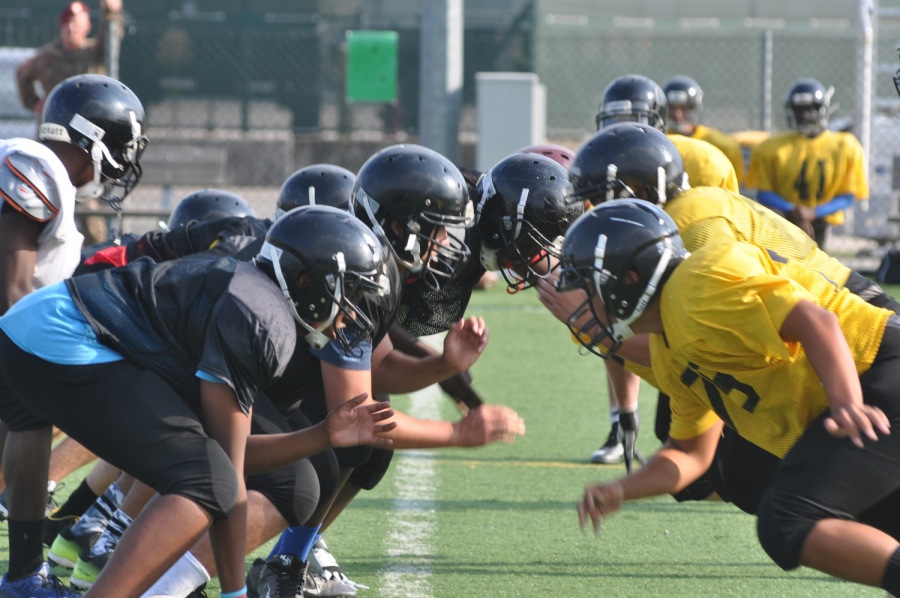
What if we have multiple two-way players?
I’ve received many versions of this question. The question infers that players who play the entire game will need more conditioning than those who don’t.
Not.
Remember, the typical high school football game consists of ten minutes of play and two hours of loitering. Five seconds on, 30 seconds off.
Only your best players will play both ways. Your best players are capable of playing hard for 100 plays, even if they never reach the same load in a given practice.
In track, I coach athletes who run elite times in the 400 meters without ever running more than a 200 in practice. We never take a lap. We never do over-distance. Our highest sprint volume in a given practice last year was 600 meters (3 x 200). Our focus is speed. When we run the 4×4 in a meet, we man up and compete.
I’ve run four marathons. I’ve proudly finished every 26.2 mile challenge. My longest workout was a 20 mile run, just once in preparing for each marathon. Every week of training featured four days of running, three days off. One year I missed two weeks of training with the Chicago Marathon looming, only six weeks away. I ran my best time that year.
I once witnessed a five year-old running the mile in 8:05. His training? None. He had never run a lap. Coaches think they are solely responsible for every step of their athletes. Not true.
If the truth be known, coaches are often responsible for how SLOW their team plays, not how fast. Their players took two many damn steps in practice. Too much. Too long. Too hard.
Keep your two-way players fast and fresh.
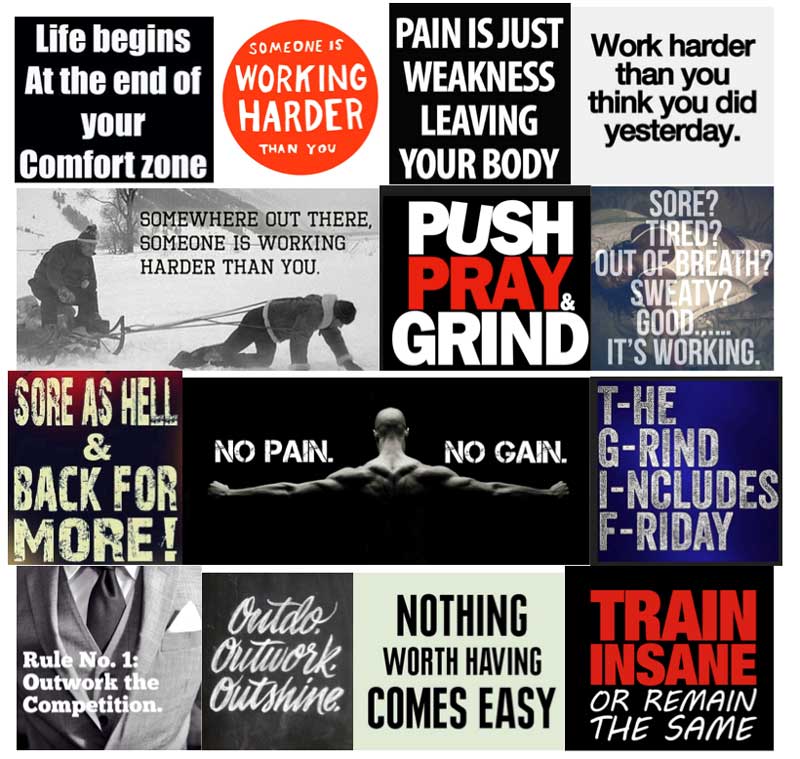 Slogans about work make football coaches tingle. Where are the slogans about speed?
Slogans about work make football coaches tingle. Where are the slogans about speed?
But won’t we be at a disadvantage in the 4th quarter if we do no conditioning?
An assistant once told me, “If we don’t run at the end of practice, we won’t finish games.” I responded, “Our games will be over by halftime.” My statement was prophetic, we led our games by an average of 40 points at halftime. We had better talent than our opponents but we also played fast as hell on game day. We made other teams look sleepy.
Here is my argument. Do you want to be faster at every position than your opponent? Or, would you rather train your team to run at three-quarter speed for three or four hours?
My track athletes build what we call a “speed reserve”. If you practice fast in football, you build the same “speed reserve”. We train at 100 mph so that 80 mph seems easy. Other teams train at 60 mph and then try to play at 80 mph. Which team would you rather be?
The fourth quarter of a football game (if the game is still in doubt), is similar to the last 100 meters of the 400. Nobody feels good. Nobody feels fresh. No matter how hard you train, the last 100m of the 400 will suck. No matter how much energy you conserve in the first 300 meters, you will hate the final 100. The same thing can be said about the final quarter of a football game. Do teams that trudge through practice for 4-hours feel fast and fresh in the 4th quarter? I’ll put my money on the fast kids.
What would you do for two-a-days to make speed the focus?
The flippant answer is easy … I would not do two-a-days.
If this sounds like blasphemy, you are a process-driven old school nut job.
If you are a renaissance man, read on.
If you practice for five hours on day-1 of two-a-days, your team will have a two day hangover. You’ve not only ruined Tuesday’s practice, you’ve ruined Wednesday, too. The downward spiral has begun.
I saw a local team who published their August schedule. For the week of August 7th, they’ve listed their practice time as 8 am to 2 pm. Six hours a day. I know the coach and I’m sure these six hour days probably include meetings, lunch, and team building, but you never know. Football coaches love the grind.
When I went to Franklin, TN, in 2004, I felt like an alien. Everyone feels like a stranger when they move to a new place, especially if they move to a new state after 23 years in the same place. When offensive coordinator Danny Nowell told me in a thick southern accent, “Coach Holler, you got your mattress ready for camp?”, I thought he was kidding. I showed up on Sunday afternoon for camp without my mattress. I was surprised to witness a scene resembling college kids moving into their dorms. Everyone had a mattress, including coaches. I went home and got mine.
Camp was the August start to the season, two-a-days. The kids slept in the auxiliary gym, the coaches slept in the offices. Wake up call was 5:30 am, breakfast served by parents at 5:45, kickers took the field at 6:30, practice started at 7:00 am. We practiced for around three and half hours, showered up, ate another parent-provided meal, rest, meetings, rest, then practice again from 5:00 until 8:00. Coaches meetings concluded around 10:30 pm. Every day lasted a week. Camp went from Sunday to Saturday. Good God.
In spite of the high volume insanity, we played for the state championship that year (biggest schools, 5A). We had really good coaches and terrific athletes who had been playing football since the age of five. The next year, our head coach, Tim Johnson, left for more money (seriously more money, also a rumored apartment and car) at Giles County. Kentucky Hall of Famer, Craig Clayton, replaced Johnson and went 65-22 in the next seven years at Franklin. Craig Clayton had short practices on Monday, Tuesday, and Wednesday and no practice on Thursday. Parent’s complained. Craig Clayton’s “poor work ethic” almost got him fired. Blasphemy.
By the way, I loved both Coach Johnson and Coach Clayton. However, I would rather be on Coach Clayton’s staff and I’d rather my boys play in a program that featured racehorses instead of plow horses.
Getting back to the question at hand. Instead of double sessions, I would practice no more than two hours. Have kids shower and eat. Then, teach in the air conditioning. Do walk-throughs in the gym. Maybe end with a minimum-dose lifting session.
Day one would be a sprint day. I would back off on day two (no sprint), then sprint again day three. I would alternate fast days and recovery days. I would do everything I could to insure that today’s practice would not ruin tomorrow’s practice.
Every bone in your body will scream “You are not doing enough!”. Let other teams practice for six hours. Be different. Be radical. Tell your players the method behind your madness. We are going to be the fastest team we can be. We are going be bouncy on Friday nights. We will have half the injuries of our opponents. We will block and tackle with enthusiasm. We will execute every play with precision and we will not tolerate mistakes. We are not practicing to get into shape, we are practicing to win!
How can I get everything installed in two hour practices?
My answer … SIMPLIFY.
Install less.
Read Essentialism.
If I see a high school coach carrying a poster-sized play sheet at the high school level, I immediately lose respect. If a coach carries a play sheet in practice I want to heckle him. If freshman and sophomore coaches need a play sheet, I’m appalled.
In full disclosure, I carried a color-coded, laminated, Excel play sheet as varsity offensive coordinator at Plainfield North in 2007 and 2008. I’m embarrassed. I fell into the “this is what they do in varsity football” trap. I now cringe at how sophisticated I pretended to be. At the high school level, if the offensive coordinator can’t keep his entire offense in his head, his offense is too complex. If the calling of a play requires a cheat sheet to get it right, the play call is too complicated.
Why should high schools copy NFL coordinators? My hero, Hal Mumme, believed in simplicity, “If you can’t call the play in four or five words, you shouldn’t be running the play.”
In 1960 George Halas of the Chicago Bears was boasting that his players had to learn 500 plays. Total bullshit. A phone-directory-sized playbook is not a sign of coaching genius, it’s a sign of buffoonery.
When implementing offense for the the first game, ask yourself, “What is the bare minimum of what we need for game one?” The best teams I’ve coached ran four running plays out of one formation, one type of motion, and four pass plays. When we got bored we would do something funky or give the quarterback license to change something at the line of scrimmage. We chose quality over quantity.
When my defensive coordinator would ask if we should do this or that on defense, my answer was always the same. “Which is simpler?”
When you have less to do, practices are shorter and speed remains the priority.
“You can teach plays or you can teach how to play.” – Bob Knight
Do you expect everyone to be in shape on day-one?
Of course. All summer you tell your kids to be ready to go. Who doesn’t expect kids to show up ready to play football?
However, we all know this never happens. We have kids who show up on day-one in game shape and others show up fat and worthless. Or maybe some nerd comes out for football who sits all summer in an air conditioned basement playing Grand Theft Auto.
So, don’t you have to get your team in shape?
You have a choice. You can focus on your good athletes and work on gaining and maintaining speed. Or you can focus on your non-athletes and get them in shape. If you opt for high volume general fitness, you are turning your racehorses into plow horses.
To me, the answer is obvious. Focus on the athletes.
Even if you make fitness the goal, how long will it take to get the fat kids in shape? How long will it take you to toughen up the nerds? Two weeks? I believe it takes at least six weeks to create physical adaptions. By the time the fat kids get lean and the nerds get tough, you are already 0-3. You’ve neglected your best athletes. You’ve neglected speed.
Why would you want to wear out your racehorses because you want to run a fitness program for fat kids and nerds?
But, I need those fat kids and nerds to play! We are a small school with limited players. If this is the case, you’re probably not going to have a great season. If you have to play the fat kids and nerds, keep them fresh, get them faster, and then live with the results.
Too many coaches think they can rearrange the deck chairs on the Titanic and save the ship from sinking.
One more thing, if you have small numbers and lots of kids going both ways, can you afford injuries? Hell no. You need every guy. That’s another reason to practice less and focus on speed. Call me crazy but a four hour of practice will cause three times as many injuries as a two hour practice. Ever notice how most injuries seem to happen in the last 45 minutes of practice?
I don’t want to bring up the C-word, but football is in trouble. The number of concussions will eventually end the game as we know it. Would short practices produce fewer concussions? (rhetorical question)
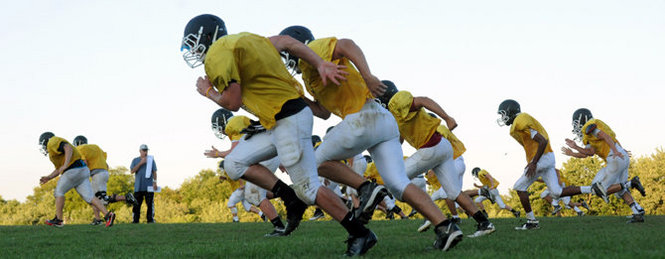
If you don’t do conditioning how will guys get in shape?
Kids will get into football shape by doing football related activities. Linemen will do things that linemen do. Receivers will stalk block and run pass routes. Running backs will take handoffs and sprint. Sounds simple to me.
If an offensive lineman hits a sled 20 times, works on individual pass protection 20 times, and goes live for 20 plays, will he be in shape to play 60 plays on Friday night? Heck yes. Especially if he is not worn down and worn out by mindless conditioning and physical torture.
Let’s say you have a big offensive tackle, 6’3, 260. Your offensive tackle will get 60 reps in Friday night’s game. Why would he need 180 reps in a practice? Why would he need 30 minutes of indiscriminate conditioning in addition to his football specific work?
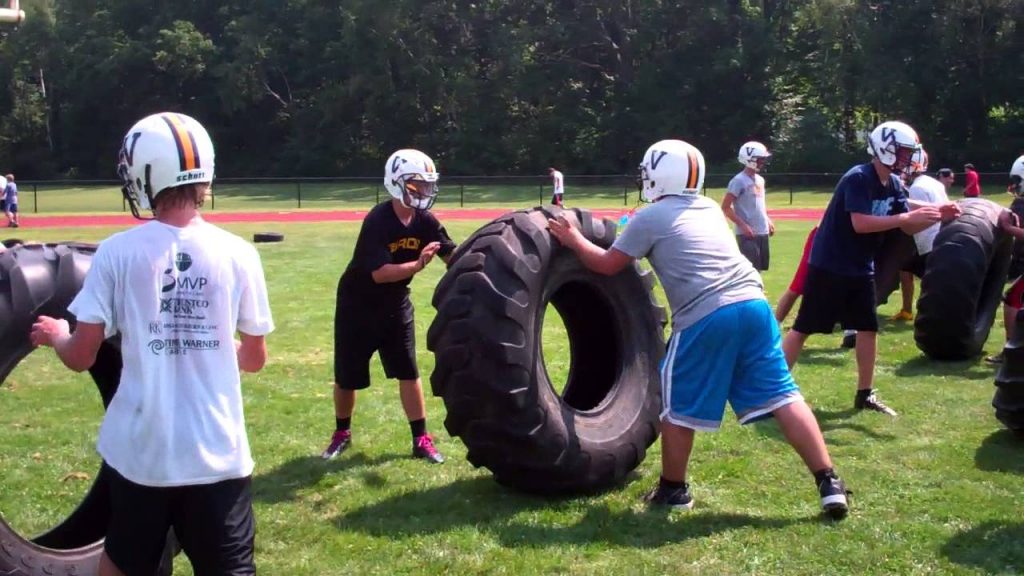 Ask yourself, is this game-specific? Does this promote high performance? Are we wasting time?
Ask yourself, is this game-specific? Does this promote high performance? Are we wasting time?
While on the subject of creating football related activities, remember we must constantly find ways to make our high speed practices game-specific. For example, a receiver running a crisp route at high speed is game specific. Practice fillers like speed ladders, running though ropes, or doing monkey rolls do nothing to create game specific work.
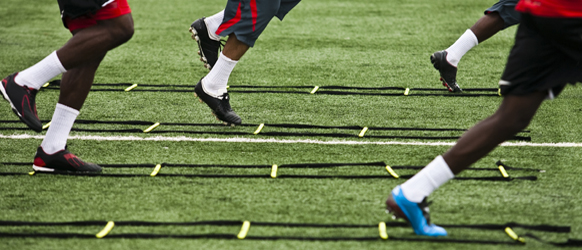 Taking six inch strides on your tippy toes never happens on Friday nights. If speed ladders are a part of your football practice, you are being laughed at by every coach I know and respect. Stop filling time with mindless nonsense.
Taking six inch strides on your tippy toes never happens on Friday nights. If speed ladders are a part of your football practice, you are being laughed at by every coach I know and respect. Stop filling time with mindless nonsense.
Bob Knight once said, “Every drill we do must be evaluated. Does this drill give us a better chance to win?”. Most basketball drills were designed to keep players moving and fill time. Very few basketball drills improved skills. Same thing with football drills.
TFC-5 speaker, Shawn Myszka, “The Movement Miyagi”, tweeted today, “Why do so many NFL position coaches insist on having players perform the same exact drills during individual periods everyday?”
The Pareto Principle applicable everywhere, 80% of our results come from 20% of our work.

How many full speed reps do you expect on your speed days?
To review, my proposed practice week laid out in New Ideas for Old School Football Coaches
- Monday – 90 minutes of skill building and fundamentals, no sprint
- Tuesday – 2 hours of high speed reps
- Wednesday – 90 minutes of game prep, no sprint
- Thursday – 60 minutes of high speed reps, low-dose
- Friday – game night, hardest workout of the week
- Saturday – off
- Sunday – off
Since Tuesday is followed by a recovery day, more reps can be done. Thursday’s practice is followed by game day, so you must be more concerned with minimum effective dose.
This is more of an art than a science. Coaches must get a feel for how much is enough. Rest must be “enough”. Reps and rest can’t be quantified but good coaches know it when they see it. I love the 1964 quote by Justice Potter Stewart when describing obscenity, “I know it when I see it.” My only advice, always err on the side of less. You can never do harm by ending practice early. Harm is caused when coaches go too hard, too long.
I guarantee, the dumbest coaches in the world have long and hard practices. It takes intelligence and confidence to simplify and shorten practice. You must go through hours of planning. What are the essentials? You must separate the wheat from the chaff. As Thelonius Monk said,“Simple ain’t easy.”
But what if you are outnumbered?
Join the club. Sometimes you can find a high-speed, less-is-more niche as a head coach at the freshman or sophomore level.
Head varsity coaches are scared shitless of getting beat using the less-is-more approach. If the ship goes down, they want to go down outworking their opponents. They want to be slaughtered like the Spartans at Thermopylae. The dignity of football coaches is rooted in hard work.
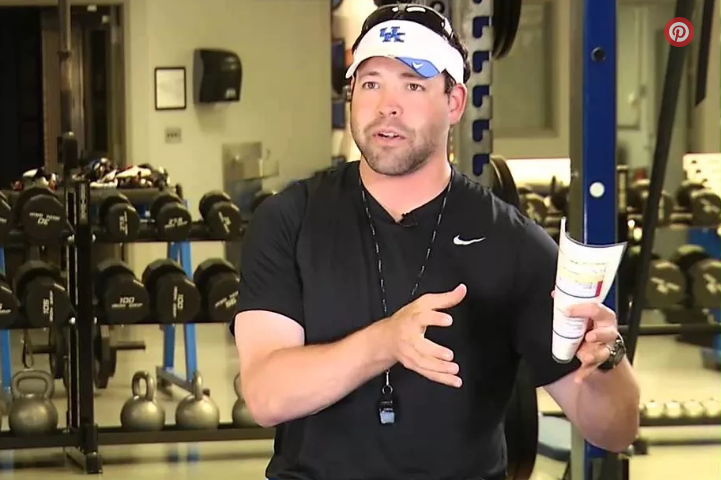
The Nature of the Beast
Erik Korem was the Director of High Performance at Kentucky under Mark Stoops in 2014. I don’t know Erik Korem but I know about him. He’s one of the guys I’d like to have speak at a future TFC. Korem has a sprint background and was the first coach in the U.S. to experiment with the $20k 1080 Sprint. Chris Korfist was the first American to buy the 1080 Sprint in 2015.
Erik Korem convinced Head Coach Mark Stoops to implement the speed-focused Radcliffe-Kelly practice week (low-volume high-speed practices on Tuesday, Wednesday, and Friday). After a short practice on the day prior to Kentucky’s first game of 2014, Mark Stoops told Korem, “Man, Erik, I loved it. I thought it worked out really well.” Then Stoops added, “But if we lose, it’s your fault.”
This is the nature of the beast. Even though Stoops was half-kidding, he was also half-serious. Kentucky hammered Tennessee-Martin 59-14, so Erik Korem’s job was safe for another week.
The 2014 season started 5-1 for Kentucky, but they finished poorly going 5-7 for the season. The next year featured a 4-1 start but the same finish, 5-7. When football coaches get beat, it’s always practice harder, practice longer, and get tougher. They also default to traditional weight room ideas, more reps and heavier weights.
Erik Korem is now the Director of Sport Science for the Houston Texans. Mark Stoops, after two 5-7 seasons, decided to go back to a more traditional S&C program. Last year Kentucky went 7-5, so I guess old school works. Ha.
Erik Korem, if you ever read this, we want you to be a presenter at a future Track Football Consortium.
Why won’t the Neanderthals listen?
We live in country where millions of kids are taught on Sundays that evolution is a hoax. I once debated evolution with one of my students. I told my student to ask their Sunday School teacher, “If the earth is only 5000 years old, what’s up with dinosaur bones?” The student asked the question and reported back to me, “God put dinosaur bones in the ground to test our faith.”
Old school football coaches are so entrenched, they are sometimes beyond reason.
My son, Alec, is a third generation coach. When you are a coach’s kid, you think like a coach long before you get your first coaching job.
Alec serves as the DB coach for Edwardsville H.S., one of the best football programs in Illinois, going 50-8 in the last five years. Alec proof read this article and his reaction is important.
“I think your article helps to convince those who want to be convinced. Most football coaches would say your guys would lack size, toughness, and strength. And, it would show up as your team goes deep into the season”
I agree, my argument for a better way to coach football will only convince people wanting to be convinced.
Lack size? That’s bullshit. Do long practices make you bigger?
Strength? Short practices would allow more time in the weight room. Fast and fresh kids play strong on Friday nights.
Toughness? Well, if you believe toughness is created by torture, we can’t be friends. The Spartans would systematically beat their boys to turn them into warriors. Some died during those torture sessions. Nope, I refuse to buy in.
Wear down late in the season? I strongly believe the opposite to be true. Who wouldn’t choose a healthier team? Who wouldn’t choose a faster team?
More from Alec:
“I think the old school programs get good results because their kids are CONFIDENT in their body of work. They BELIEVE they won’t wear down in the fourth quarter because they’ve worked so hard. They BELIEVE no one is tougher because no one has gone through the shit they’ve gone through. If you run a speed-based program, players may have a seed of DOUBT. ‘Maybe we’re going to be dead in the fourth quarter because other teams outworked us?'”
Once again, Alec is on target. Belief is a powerful thing. The brain always wins.
If you adopt a speed-based approach to football, you better sell it. You better sell it just as good as other coaches sell “the grind”. Your players better believe in the FACTS. Fast players are better than slow players. Great teams block and tackle. Turnovers are critical. Execution or a lack of execution will win or lose the fourth quarter. Your players must BELIEVE.
One last thing. If you adopt my ideas on dosage and approach, be prepared for opposition. If you go 8-1, someone will blame your one loss on your kids playing soft because you didn’t practice long enough and hard enough. Your team got lucky in the eight wins.
Then again, you could ask yourself the question every educator should ask everyday, “What’s best for kids?”.
Please forward this article to football coaches you know. Start a conversation about the modus operandi of football at your school.
+++
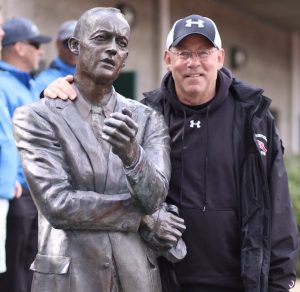
Tony Holler has taught Chemistry and coached track for 36 years at three different high schools, Harrisburg (IL), Franklin (TN), and Plainfield North (IL). Inducted into the ITCCCA Hall of Fame in 2015, Holler’s teams have continued to feature great sprinters. Along with Chris Korfist, Holler co-directs the Track Football Consortium held twice a year (June and December). Holler has written over 100 articles promoting the sport of track and field and sharing everything he knows. His articles can be found at ITCCCA.com, FreelapUSA.com, and SimpliFaster.com. You can follow Coach Holler on Twitter @pntrack and email him at tony.holler@yahoo.com.
Don’t miss videos from past consortiums! Videos
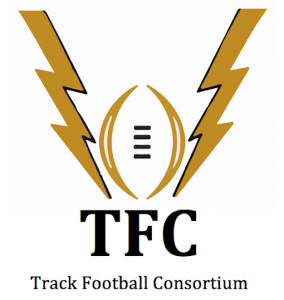

What would your weight-training program look like for a football program?
In-season weight room would be, of course, less-is-more (minimum effective dose). Always lift fresh, never after practice. Always lift with focus and enthusiasm (and this must come from the entire coaching staff). If kids are lazy and unfocused, end the session and go to practice. “No pain no gain” is total bullshit in-season. No lift session should have a negative affect on practice the next day.